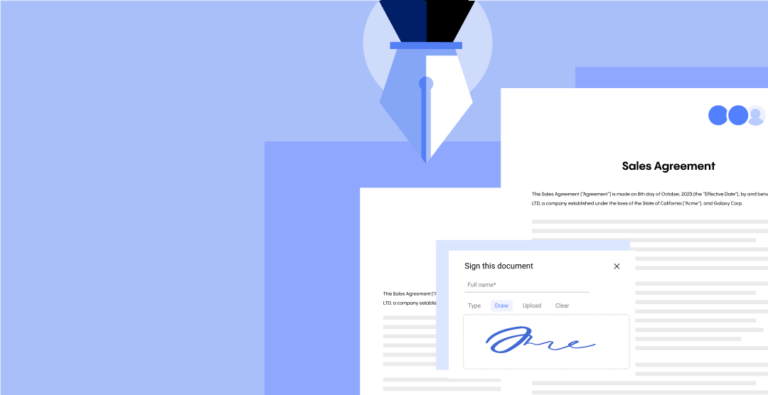Contract Lifecycle Management Software: Concord
Quickly centralize, automate, and manage every contract—boosting productivity and reducing risk immediately
- Cut approval times by 30%, with automated workflows
- Centralize every document, securely stored and instantly searchable
- Real-time negotiation, eliminate delays and close faster
“Concord is my one-stop shop for the entire contract lifecycle. It’s Google docs, Microsoft Word, DocuSign and a File explorer, all in one.”

Hannah L., ⭐⭐⭐⭐⭐
Book a demo
Try an interactive demo of Concord’s contract lifecycle management software
What is contract lifecycle management software?
Definition: CLM software is a digital platform that manages contracts from creation to renewal, automating workflows and providing analytics.
Key components of Concord’s CLM software:
- Contract creation & templates
- Negotiation & redlining
- E-signature & execution
- Obligation tracking
- Renewal management
- Analytics & reporting
Concord CLM includes all these components in one platform starting at $399/month.
Real-world impact: Case studies in contract lifecycle management software
Case Study: Standardized Workflows Save Time and Money at Yates Construction

Key Benefits:
- • Centralized repository
- • Automated workflows
- • Version control
With 5,000 employees across 15 divisions, Yates Construction struggled with decentralized contract processes that created delays and compliance risks.
How Concord helped:
- • Concord unified all 15 divisions on one platform
- • Automated sending replaced manual email chains
- • Clear audit trails prevent unauthorized edits
“A lot of subcontractors refuse to go to work until they have a signed contract, so Concord gets our projects moving much faster. It provides tools that enable you to use it the way you need to.” — Jenny McMullen, Corporate Contract Administrator
Contract Lifecycle Management Evolution
Contract Creation Phase
The contract creation phase is where the foundation of your agreement begins. This critical first step establishes the terms, conditions, and expectations that will guide the entire relationship.
- Manual drafting with inconsistent templates
- Time-consuming approval routing
- Duplicate content across contracts
- Limited visibility into contract status
- AI-powered template suggestions
- Automated approval workflows
- Centralized clause library
- Real-time status visibility
Contract Negotiation Phase
Negotiations can make or break your deals. This phase determines whether the contract will be fair, balanced, and acceptable to both parties - while also meeting your organization's standards and requirements.
- Email-based version tracking
- Offline redlining processes
- Difficulty tracking changes across versions
- Slow approval and review cycles
- Online redlining & real-time tracking
- Version comparison & history
- In-app commenting & discussions
- Mobile access for approval anywhere
Contract Execution Phase
The execution phase transforms an agreement from a draft into a legally binding document. The efficiency of this process can significantly impact your business velocity and relationship management.
- Printing, scanning, and mailing documents
- Manual signature tracking
- Slow multi-party signing sequences
- Manual document distribution after signing
- Secure e-signatures from any device
- Automated signature routing
- Real-time status tracking
- Instant access to executed documents
Contract Compliance Phase
Compliance management is where organizations often struggle most. Without effective systems, companies lose 9.2% of contract value through poor monitoring and missed obligations.
- Manual obligation tracking in spreadsheets
- Periodic manual audits
- Reactive issue management
- Limited visibility into compliance status
- AI-powered obligation extraction
- Automated compliance monitoring
- Proactive deadline notifications
- Real-time compliance dashboards
Contract Renewal Phase
The renewal phase determines whether value is preserved or lost. Without proper management, organizations face auto-renewals of unfavorable terms or service disruptions from missed renewals.
- Calendar-based renewal reminders
- Last-minute renewal decisions
- Limited performance data for negotiations
- Missed renegotiation opportunities
- Automated renewal notifications
- Early renewal planning workflows
- Performance analytics for negotiations
- Strategic renewal opportunity dashboard

Core capabilities of modern CLM software
Modern CLM software offers a comprehensive suite of capabilities designed to address each phase of the contract lifecycle. Understanding these core functionalities is essential for organizations evaluating potential solutions:
1. Contract creation and authoring
Modern CLM platforms streamline the contract creation process through:
- Template libraries: Standardized, pre-approved templates for common agreement types that ensure consistency and compliance
- Clause libraries: Collections of approved clauses that can be dynamically inserted based on specific contract parameters
- Dynamic assembly: Rules-based document generation that automatically customizes agreements based on transaction details
- Collaborative drafting: Tools that enable multiple stakeholders to contribute to document creation while maintaining version control
Research by Wolters Kluwer indicates that automated workflows in contract creation can lead to time savings of 20-50%, allowing legal professionals to focus on more strategic matters rather than routine document assembly.
2. Negotiation and approval
The negotiation phase often creates significant bottlenecks in contract processes. CLM software addresses these challenges through:
- Redlining and version control: Tracking changes and maintaining a clear history of revisions throughout negotiations
- Comparison tools: Side-by-side analysis of contract versions to quickly identify changes
- Approval workflows: Configurable routing rules that ensure appropriate stakeholder review based on contract type, value, or risk profile
- Negotiation playbooks: Guidance on acceptable fallback positions for commonly negotiated terms
According to Summize, implementing a CLM solution can achieve 45% operational efficiency gains in the negotiation and supplier contract creation process, with AI-powered contract review saving up to 85% of manual review time.
3. Execution and signature
Once terms are finalized, CLM systems facilitate efficient execution through:
- Electronic signature integration: Seamless connections to e-signature providers for legally binding digital execution
- Signatory management: Automatic routing to required signatories in the correct sequence
- Status tracking: Real-time visibility into the signature process
- Execution records: Complete audit trails of the signature process for compliance and record-keeping
4. Obligation management
After execution, CLM software ensures that contractual commitments are fulfilled through:
- Obligation extraction: Automated identification of key responsibilities and deadlines
- Task assignment: Delegation of specific obligations to appropriate owners
- Proactive alerts: Automated notifications for upcoming deadlines or required actions
- Performance tracking: Monitoring and reporting on obligation fulfillment status
Wolters Kluwer notes that proactive alerts for significant milestones like contract expiry or renewal provide essential insights into the business impact of these events, preventing organizations from being caught off guard by critical deadlines.
5. Amendment and renewal management
Throughout the contract term, CLM systems facilitate changes and renewals via:
- Amendment workflows: Streamlined processes for modifying existing agreements
- Renewal forecasting: Advance visibility into upcoming renewal opportunities
- Auto-renewal alerts: Notifications for contracts with automatic renewal provisions
- Term optimization: Analysis of renewal opportunities to improve contractual terms
6. Analytics and reporting
Perhaps most importantly, modern CLM systems transform contract data into actionable business intelligence through:
- Performance dashboards: Visual representations of key contract metrics
- Custom reporting: Configurable reports on contract types, values, terms, and status
- Risk analysis: Identification of potential contractual risks across the portfolio
- Spend analysis: Insights into contract-related expenditures and opportunities for optimization
CLM software capabilities comparison
When evaluating CLM solutions, organizations should consider how different offerings address their specific requirements. The following table compares key capabilities across different types of CLM solutions:
| Capability | Basic CLM | Mid-Range CLM | Enterprise CLM |
|---|---|---|---|
| Document Management | Simple repository with basic search | Structured repository with metadata tracking | AI-powered repository with automatic classification |
| Contract Creation | Standard templates | Template library with clause management | Dynamic assembly with guided authoring |
| Workflow Automation | Basic approval routing | Configurable workflows with notifications | Advanced workflows with conditional logic |
| Negotiation Support | Version tracking | Collaborative redlining with version comparison | AI-powered negotiation guidance |
| Obligation Management | Manual tracking | Automated extraction and assignment | Proactive monitoring with risk assessment |
| Analytics & Reporting | Standard reports | Customizable dashboards | Predictive analytics with business insights |
| Integration Capabilities | Limited (e.g., e-signature) | Moderate (CRM, ERP, e-signature) | Extensive ecosystem with bidirectional data flow |
| Implementation Complexity | Low (weeks) | Medium (2-3 months) | High (4+ months) |
| Typical Annual Cost | $10K-$30K | $30K-$100K | $100K+ |
| Best Suited For | SMBs with straightforward contracts | Mid-market with diverse contract needs | Enterprises with complex global requirements |
This comparison demonstrates how CLM capabilities scale to meet different organizational needs and budgets. Organizations should evaluate their requirements against these capabilities to identify the most appropriate solution tier.
/c
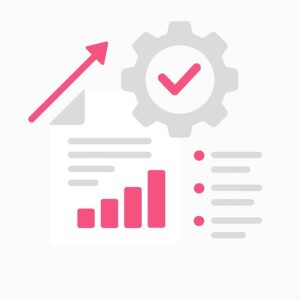
Key benefits of CLM software implementation
Organizations that successfully implement contract management software realize numerous benefits that extend well beyond basic operational efficiency:
Operational efficiency
Contract automation software significantly streamlines contract processes, reducing manual effort and accelerating cycle times:
- Reduced cycle time: According to Aberdeen Group, CLM platforms can reduce contract approval times by 82%, decreasing the timeline from an average of 3.4 weeks to just days.
- Administrative savings: CLM systems can save organizations an estimated 9.4% in administrative costs related to contract management.
- Increased throughput: Automation of routine tasks enables teams to handle higher contract volumes without adding headcount.
Risk mitigation
Effective contract management is essential for identifying and addressing potential risks:
- Compliance enforcement: Ensuring adherence to regulatory requirements and internal policies through standardized processes and proactive monitoring.
- Obligation fulfillment: Reducing the risk of missed deadlines or commitments through automated tracking and alerts.
- Consistency improvement: Standardizing contract language to eliminate problematic variations that could create unintended liabilities.
Financial optimization
Beyond operational and risk benefits, legal contract management software delivers measurable financial improvements:
- Revenue acceleration: Faster contract cycles translate directly to quicker revenue recognition.
- Spend management: Greater visibility into supplier agreements enables more effective vendor management and cost control.
- Discount capture: Timely awareness of early payment discount opportunities increases savings.
- Leakage prevention: Systematic tracking of contract terms prevents revenue leakage from pricing errors, missed renewals, or overlooked obligations.
CLM customers achieved ROI between 121% and 356% from their implementations, demonstrating the substantial financial benefits of effective contract management.
Strategic insights
Advanced CLM platforms transform contract data into valuable business intelligence:
- Performance analytics: Measuring and comparing supplier or customer performance against contractual commitments.
- Market benchmarking: Comparing internal contract terms against industry standards to identify optimization opportunities.
- Negotiation leverage: Using historical contract data to strengthen future negotiating positions.
- Relationship management: Identifying opportunities to strengthen key business relationships through proactive contract management.
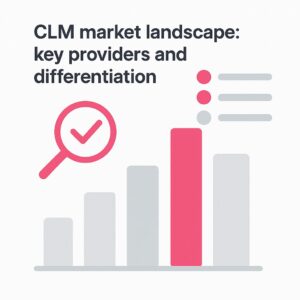
CLM market landscape: key providers and differentiation
The CLM software market features a diverse ecosystem of providers, ranging from specialized contract management vendors to broader enterprise software companies that include CLM capabilities within their suites. Understanding this landscape is essential for organizations evaluating potential solutions.
Enterprise CLM providers
Enterprise-focused CLM providers offer comprehensive platforms designed for large organizations with complex contract ecosystems:
- Icertis: Known for its AI-driven contract intelligence platform that extends beyond basic management to provide deeper insights and integration capabilities.
- DocuSign CLM: Builds on DocuSign’s e-signature foundation to offer end-to-end contract management capabilities with strong execution features.
- Coupa CLM: Integrates contract management with broader procurement and spend management functionality for a unified approach to supplier relationships.
- SAP Ariba Contract Management: Provides CLM capabilities within SAP’s broader procurement and supply chain ecosystem.
Mid-market CLM solutions
Several providers focus on the mid-market segment, offering robust functionality with more streamlined implementation approaches:
- Concord: Delivers an intuitive platform that emphasizes ease of use and quick time-to-value for growing organizations.
- Agiloft: Offers a highly configurable solution that can be customized to diverse business requirements without custom coding.
- ContractWorks: Focuses on simplifying contract management with straightforward repository and tracking capabilities.
- PandaDoc: Combines document creation, workflow, and e-signature capabilities in an integrated platform.
Specialized and emerging players
The market also includes specialized providers that focus on specific industries or contract types:
- JAGGAER: Targets complex sourcing and procurement contracts with specialized capabilities for these use cases.
- Conga CLM: Emphasizes integration with Salesforce for organizations heavily invested in that ecosystem.
- Sirion: Specializes in complex service contracts and supplier relationship management.
- Evisort: Leverages AI for contract analysis and data extraction with a focus on rapid implementation.
Why Choose Concord Over Other CLM Solutions
Concord’s Unique Advantages:
- 14-day implementation vs. 4-6 months for enterprise CLM
- No per-user pricing – unlimited users included
- AI-powered data extraction with zero data retention policy
- Native e-signature included (no DocuSign fees)
- 5,000+ integrations via Zapier (vs. limited enterprise APIs)
Trusted by 500+ companies who previously used: Ironclad (32%), DocuSign CLM (28%), Manual processes (40%)
| Feature | Concord | Enterprise CLM | Why It Matters |
|---|---|---|---|
| Implementation Time | 14 days | 4-6 months | Faster time to value |
| Starting Price | $17/month | $100k+/year | 90% lower entry cost |
Concord CLM Performance Data (2024 Analysis)
Based on analysis of 500+ Concord customers:
- Average contract cycle time: 3.2 days (vs. industry average 20 days)
- Contract value retained through better renewal management: $2.3M average
- Time to first executed contract: 48 hours after setup
Methodology: Analysis of 50,000+ contracts processed through Concord in 2024
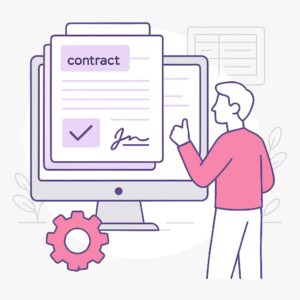
Implementation best practices: ensuring CLM success
While CLM software offers significant potential benefits, successful implementation requires careful planning and execution. Industry experiences and expert recommendations highlight several best practices:
1. Define clear objectives and success metrics
Before selecting a CLM solution, organizations should clearly articulate what they hope to achieve and how they will measure success. According to World Commerce & Contracting, setting clear goals and defining discrete milestones for your CLM journey is essential for demonstrating early value.
Key considerations include:
- Specific pain points: Identifying the most pressing contract management challenges that need immediate attention
- Priority processes: Determining which contract types or departments will be addressed first
- Measurable outcomes: Establishing concrete metrics to evaluate implementation success, such as cycle time reduction, cost savings, or compliance improvement
- Timeline expectations: Setting realistic expectations for implementation phases and value realization
2. Secure cross-functional alignment
Contract management inherently spans multiple business functions. Successful CLM implementations require buy-in from diverse stakeholders:
- Legal teams: Typically the primary users and often the champions of CLM initiatives
- Procurement: Major stakeholders for supplier agreements and purchasing contracts
- Sales: Concerned with customer agreements and revenue-generating contracts
- Finance: Invested in financial terms, obligations, and revenue recognition
- IT: Essential for system integration, data security, and technical implementation
- Business units: End users who initiate contracts and manage relationships
KPMG emphasizes the importance of stakeholder involvement and understanding how each business function interacts with contracts throughout the organization.
3. Take a phased implementation approach
Rather than attempting a “big bang” implementation across all contract types and departments, organizations should consider a phased approach:
| Implementation Phase | Timeline | Key Activities | Expected Outcomes |
|---|---|---|---|
| Foundation | 1-3 months |
|
|
| Expansion | 3-9 months |
|
|
| Optimization | 9+ months |
|
|
This incremental approach delivers value more quickly while allowing for learning and adaptation throughout the implementation process.
4. Prioritize data quality and migration
The value of a CLM system depends significantly on the quality of contract data it contains. Organizations should:
- Cleanse existing data: Review and standardize contract metadata before migration
- Prioritize active agreements: Focus initial migration efforts on current contracts with ongoing obligations
- Establish data governance: Define standards for contract data quality and maintenance
- Leverage AI for extraction: Use automated tools to extract key terms from legacy contracts
McKinsey & Company notes that effective data preparation and migration are critical first steps in any CLM implementation project.
5. Focus on user adoption
Even the most sophisticated CLM system will fail to deliver value if users don’t embrace it. Successful implementations include:
- Intuitive user experience: Choosing solutions that align with existing workflows and minimize learning curves
- Comprehensive training: Providing role-specific education on system capabilities and processes
- Change management: Communicating benefits and addressing resistance to new processes
- Ongoing support: Ensuring users have access to assistance as they adapt to the new system
Concord’s research highlights the importance of user adoption, noting that implementation success depends heavily on selecting tools that help teams move faster without complicating their jobs.
See Concord’s contract lifecycle management software in action.

Common implementation challenges and solutions
Despite careful planning, organizations often encounter challenges during CLM implementation. Understanding these common obstacles and how to address them can improve the likelihood of success:
Data migration complexities
Challenge: Many organizations struggle with migrating existing contracts into new CLM systems, particularly when dealing with poor legacy data quality or inconsistent formats.
Solution:
- Conduct thorough data assessment before migration
- Implement automated data extraction tools to facilitate the process
- Consider a progressive migration strategy focusing on the most important contracts first
- Establish clear data quality standards for newly created contracts
Integration with existing systems
Challenge: CLM software must connect with multiple business systems, from CRM and ERP to e-signature and payment processing platforms.
Solution:
- Prioritize integrations based on business value and technical feasibility
- Validate integration capabilities during the vendor selection process
- Leverage pre-built connectors where available
- Ensure IT involvement in integration planning and execution
Resistance to process changes
Challenge: Users accustomed to existing contract processes may resist adopting new workflows and technologies.
Solution:
- Involve end users in the selection and implementation process
- Emphasize benefits specific to each user group
- Provide comprehensive training tailored to different roles
- Start with quick wins that demonstrate immediate value
- Secure visible executive sponsorship for the initiative
Scope creep
Challenge: As implementation progresses, stakeholders often identify additional requirements or desire more complex functionality than initially planned.
Solution:
- Clearly define minimum viable product (MVP) criteria at the outset
- Implement a formal change control process for new requirements
- Maintain focus on core objectives and success metrics
- Plan for future enhancements in subsequent project phases

CLM implementation ROI: measuring success
Quantifying the return on investment from CLM implementation is essential for justifying the initial investment and securing resources for ongoing optimization. Organizations should consider multiple dimensions of value:
Efficiency metrics
- Cycle time reduction: Average time from contract request to execution
- Administrative time savings: Hours saved through automation of routine tasks
- Self-service adoption: Percentage of contracts initiated through self-service channels
- Process exception rate: Frequency of deviations from standard workflows
Risk and compliance metrics
- Contract risk score improvement: Reduction in aggregate risk ratings across the portfolio
- Compliance rate: Percentage of contracts adhering to required standards and terms
- Obligation fulfillment: Rate of on-time completion of contractual commitments
- Audit findings: Reduction in contract-related audit issues
Financial metrics
- Cost avoidance: Savings from improved contract terms or avoided penalties
- Revenue acceleration: Additional revenue recognized through faster contract processes
- Resource optimization: Ability to handle increased contract volume without adding headcount
- Direct savings: Reduction in external legal spend for routine contract matters
According to a 2019 Forrester analysis highlighted by Aberdeen Group, organizations implementing CLM software achieved a remarkable 356% ROI over three years, saved $4 million on contract processing costs, and grew revenues by almost $339,000 within the same timeframe.
Similarly, Cottrill Research found that companies implementing CLM platforms achieved a 1% larger average deal size, 2.5% higher annual renewal rate, and 24% shorter sales cycles—demonstrating substantial financial benefits beyond simple operational improvements.

The future of CLM software: emerging trends
As technology continues to evolve, several trends are shaping the future of contract lifecycle management software:
1. Advanced AI capabilities
Artificial intelligence is revolutionizing contract management beyond basic data extraction:
- Generative AI for drafting: Using large language models to generate contract language based on specific parameters
- Risk prediction: Identifying potential issues before they materialize based on contract language and historical performance
- Negotiation intelligence: Providing guidance on negotiation strategies based on historical outcomes
- Automated summarization: Creating plain-language summaries of complex legal documents
2. Blockchain for contract execution
Blockchain technology offers promising applications for contract management:
- Smart contracts: Self-executing agreements that automatically enforce terms when conditions are met
- Immutable audit trails: Tamper-proof records of contract history and changes
- Decentralized verification: Distributed validation of contract authenticity and status
- Automated payments: Trigger-based financial transactions linked to contract milestones
3. Extended ecosystem integration
CLM platforms are expanding their integration capabilities to connect with broader business ecosystems:
- Supply chain visibility: Linking contract terms with supply chain performance and logistics data
- Financial planning integration: Connecting contract obligations to budgeting and forecasting systems
- Customer success alignment: Coordinating contract terms with customer health and success metrics
- Regulatory compliance systems: Ensuring contracts remain aligned with evolving regulatory requirements
4. Enhanced collaboration capabilities
Future CLM systems will further streamline collaboration across complex stakeholder networks:
- In-context communication: Discussion and negotiation capabilities embedded directly within contract documents
- External collaboration portals: Secure environments for negotiation with external parties
- Knowledge management integration: Connecting contract insights with organizational knowledge bases
- Mobile optimization: Fully-featured mobile experiences for contract review and approval
Frequently Asked Questions
What is contract lifecycle management software and how does it differ from basic contract management?
Contract lifecycle management software provides comprehensive capabilities across the entire contract journey—from creation and negotiation through execution, obligation management, and renewal. Unlike basic contract management that focuses on document storage, CLM software offers AI-powered automation, advanced analytics, and strategic insights that transform contracts into business assets.
How much ROI can organizations expect from contract lifecycle management software?
Organizations implementing contract lifecycle management software typically achieve ROI between 121% and 356% within three years. Benefits include 24% shorter sales cycles, 2.5% higher renewal rates, 82% reduction in contract approval times, and savings of up to $4 million in contract processing costs for enterprise implementations.
What are the essential features to look for in contract lifecycle management software?
Essential CLM software features include centralized repository with advanced search, template and clause libraries, collaborative drafting tools, configurable workflow automation, e-signature integration, obligation extraction and tracking, renewal management, comprehensive analytics, and robust integration capabilities with CRM, ERP, and other business systems.
How long does it take to implement contract lifecycle management software?
Contract lifecycle management software implementation typically follows a phased approach: Foundation phase (1-3 months) for repository setup and basic workflows, Expansion phase (3-9 months) for additional contract types and integrations, and Optimization phase (9+ months) for advanced analytics and continuous improvement. Organizations can accelerate value by starting with high-impact use cases.
Is contract lifecycle management software suitable for small and medium businesses?
Yes, modern cloud-based contract lifecycle management software offers scalable options for organizations of all sizes. Small and medium businesses often realize proportionally greater benefits due to limited resources for manual contract management. The key is selecting right-sized solutions with core functionality like template standardization and workflow automation.
What security features should contract lifecycle management software include?
Contract lifecycle management software should provide enterprise-grade security including SOC 2 Type II certification, GDPR compliance, comprehensive audit trails, custom permission controls, and zero data retention policies for AI training. These features ensure contract data remains protected throughout the entire lifecycle.
How does AI enhance contract lifecycle management software capabilities?
AI enhances contract lifecycle management software through automated data extraction, intelligent clause recognition, risk identification, obligation tracking, and predictive analytics. Advanced AI features include generative contract drafting, negotiation guidance based on historical outcomes, and anomaly detection to identify potential issues before they materialize.
What integration capabilities are important for contract lifecycle management software?
Contract lifecycle management software should offer two-way data synchronization with CRMs and ERPs, automated triggers based on contract events, native integrations with e-signature platforms, and APIs for custom connections. Effective integrations create a single source of truth for contract data across all business systems.
The problem Concord solves
Managing contracts is difficult because they can be scattered across different places: emails, cloud drives, personal drives, and even paper copies.
Many companies rely on spreadsheets to store contract details like lifecycle dates and total contract value, but these spreadsheets don’t provide a full view of the contract, and it’s tedious to keep updated.
When contracts are saved on personal drives, critical information—like renewal dates and deadlines—is hidden from the rest of the team. This can cause headaches for audits.
If a renewal date is missed, contracts may auto-renew without the chance to renegotiate terms, potentially locking the company into bad deals.
Worse, important contracts could expire without notice, leading to service disruptions, penalties, or lost business opportunities.
Concord solves these problems with its AI-powered full contract lifecycle management platform.
Before Concord
After Concord

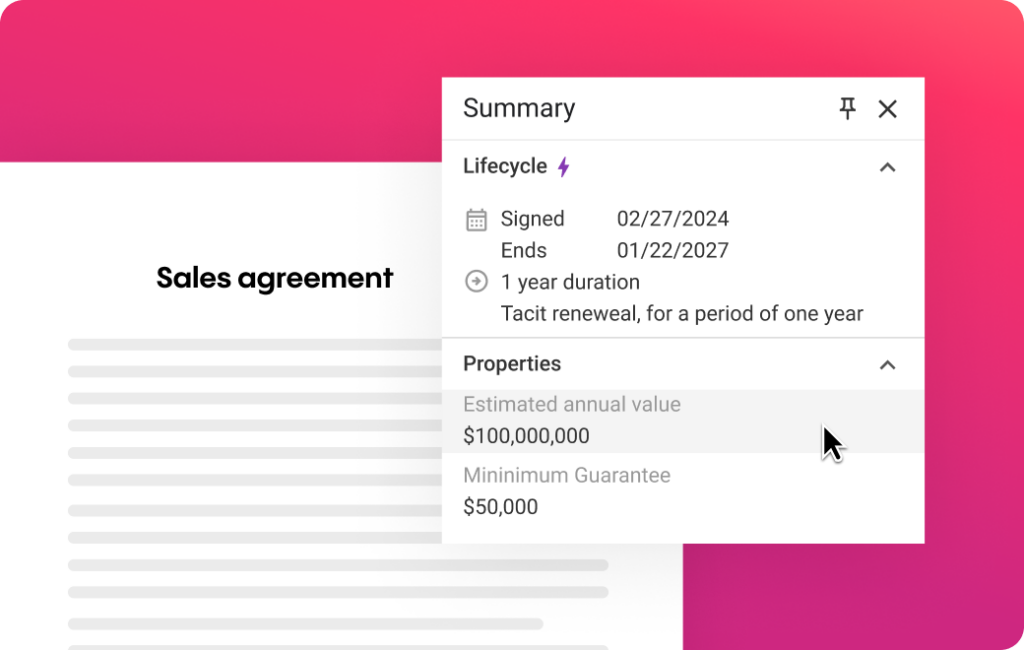
One Place for all your Contracts
Unlimited storage
Store every contract, securely, without worrying about limits

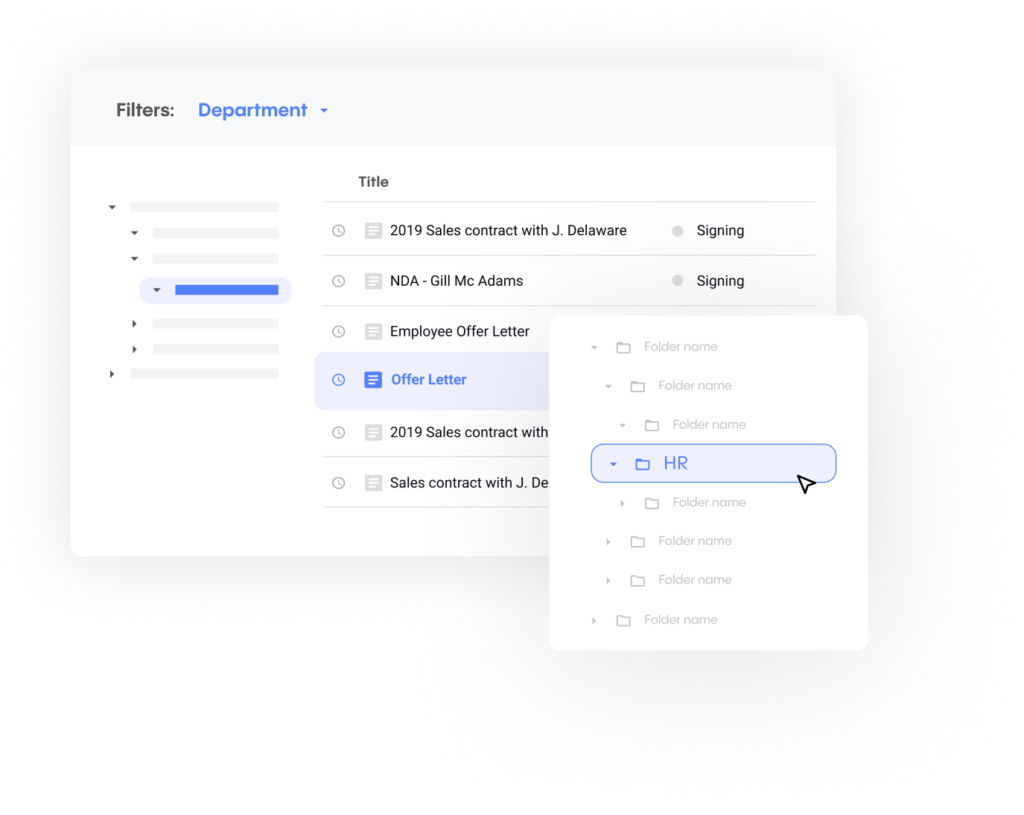
Custom permissions
Control who accesses each document with custom permission settings
Smart search
Find any contract instantly with powerful search and filtering tools
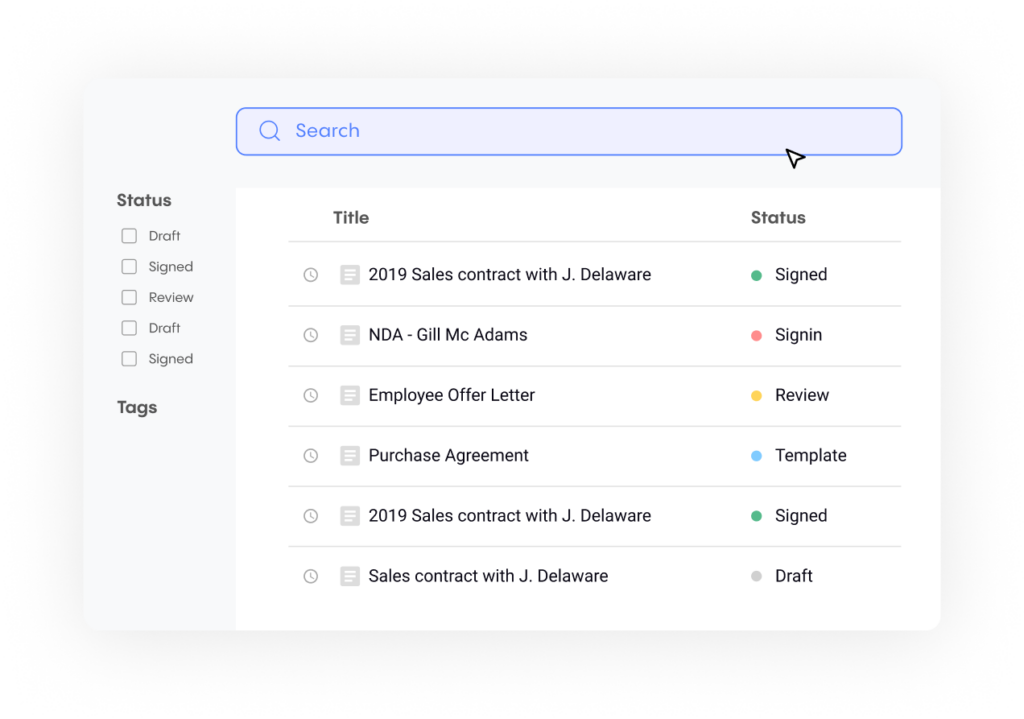

Real-time collaboration
Work together seamlessly with team members, regardless of location or department
Automate the contract lifecycle with contract lifecycle management software
Custom workflows
Set up unlimited approval workflows for every type of contract


Notifications and reminders
Never miss another renewal date or approval with smart alerts
CASE STUDY
Concord saves Sevita $5,000+ per month on auto-renewals
“Many hours saved, many dollars saved in contracts that we meant to terminate and forgot.”
Read the case study
Jennifer Neville
Associate Corporate General Counsel at Sevita
The Highest Level of Security for your Contracts
Enterprise-grade Security
Concord implements enterprise-grade measures, including SOC 2 Type II certification, GDPR compliance, and a Star Level One rating from the Cloud Security Alliance.
Audit Trails
Track every interaction with contracts for complete transparency and accountability
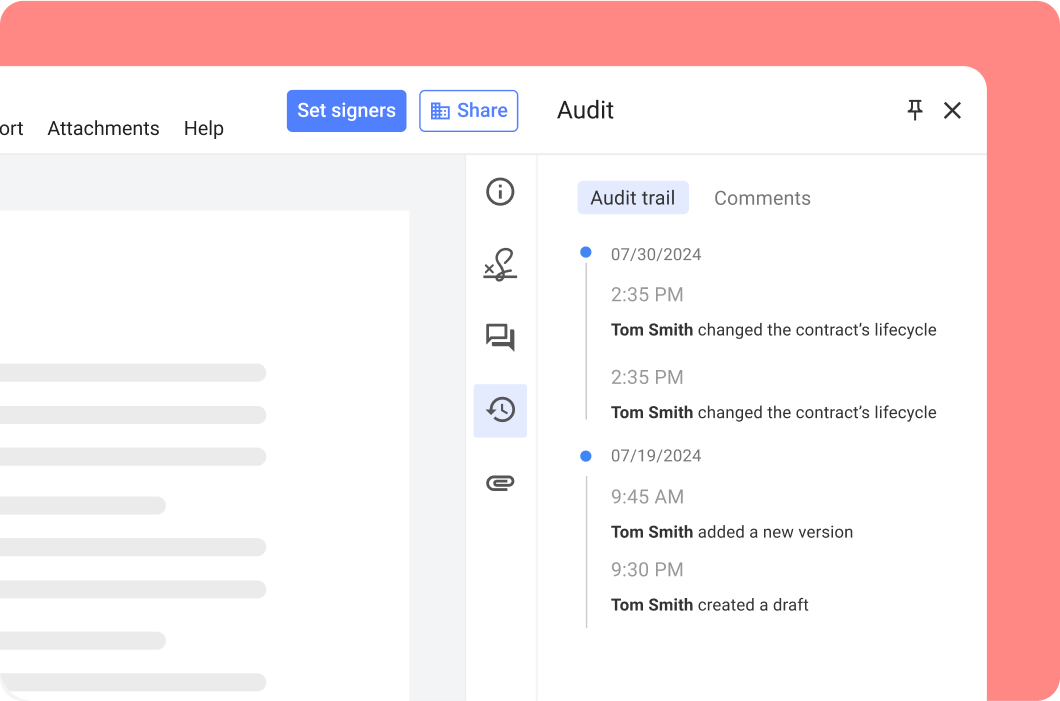
Easily Connect to your Existing Stack
CRM Integration
Create contracts that auto-fill with data from your CRM deals – then share, negotiate, and sign them in Concord
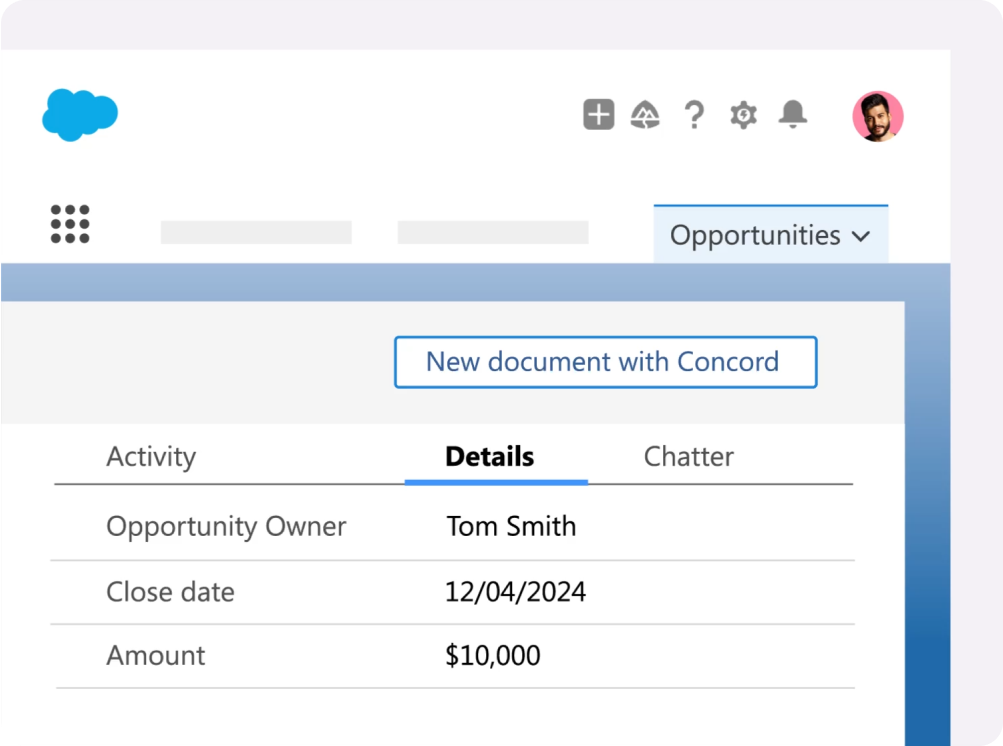
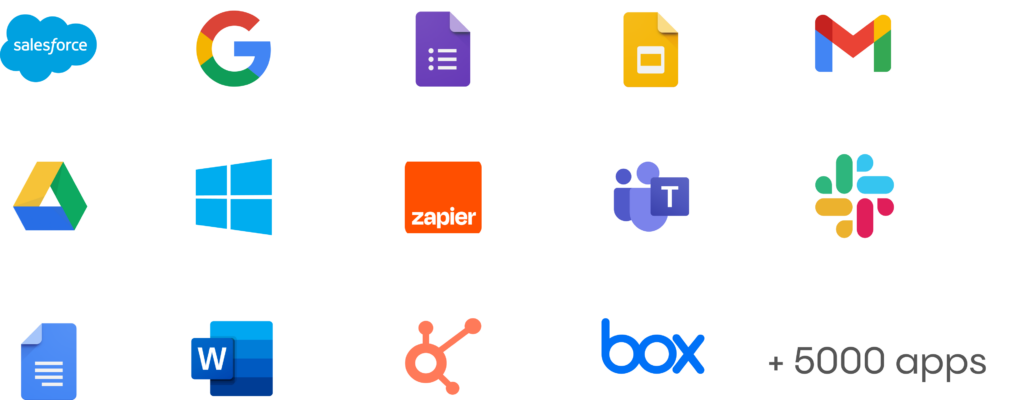
Zapier
Connect with over 5,000 apps to automate workflows across platforms

